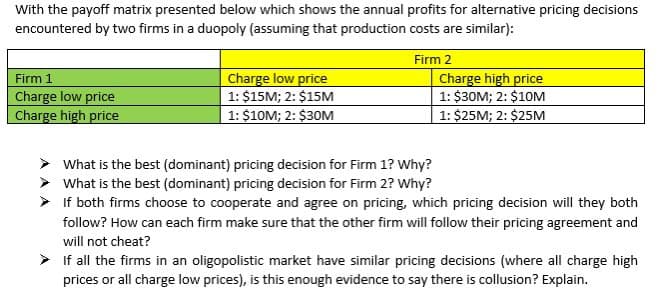With the payoff matrix presented below which shows the annual profits for alternative pricing decisions encountered by two firms in a duopoly (assuming that production costs are similar): Firm 2 Firm 1 Charge low price 1: $15M; 2: $15M Charge low price Charge high price 1: $30M; 2: $10M 1: $25M; 2: $25M Charge high price 1: $10M; 2: $30M ➤What is the best (dominant) pricing decision for Firm 1? Why? What is the best (dominant) pricing decision for Firm 2? Why? If both firms choose to cooperate and agree on pricing, which pricing decision will they both follow? How can each firm make sure that the other firm will follow their pricing agreement and
With the payoff matrix presented below which shows the annual profits for alternative pricing decisions encountered by two firms in a duopoly (assuming that production costs are similar): Firm 2 Firm 1 Charge low price 1: $15M; 2: $15M Charge low price Charge high price 1: $30M; 2: $10M 1: $25M; 2: $25M Charge high price 1: $10M; 2: $30M ➤What is the best (dominant) pricing decision for Firm 1? Why? What is the best (dominant) pricing decision for Firm 2? Why? If both firms choose to cooperate and agree on pricing, which pricing decision will they both follow? How can each firm make sure that the other firm will follow their pricing agreement and
Managerial Economics: Applications, Strategies and Tactics (MindTap Course List)
14th Edition
ISBN:9781305506381
Author:James R. McGuigan, R. Charles Moyer, Frederick H.deB. Harris
Publisher:James R. McGuigan, R. Charles Moyer, Frederick H.deB. Harris
Chapter12: Price And Output Determination: Oligopoly
Section: Chapter Questions
Problem 1E
Related questions
Question
I need answer ASAP.Thank you!

Transcribed Image Text:With the payoff matrix presented below which shows the annual profits for alternative pricing decisions
encountered by two firms in a duopoly (assuming that production costs are similar):
Firm 2
Firm 1
Charge low price
1: $15M; 2: $15M
Charge low price
Charge high price
1: $30M; 2: $10M
1: $25M; 2: $25M
Charge high price
1: $10M; 2: $30M
What is the best (dominant) pricing decision for Firm 1? Why?
What is the best (dominant) pricing decision for Firm 2? Why?
If both firms choose to cooperate and agree on pricing, which pricing decision will they both
follow? How can each firm make sure that the other firm will follow their pricing agreement and
will not cheat?
If all the firms in an oligopolistic market have similar pricing decisions (where all charge high
prices or all charge low prices), is this enough evidence to say there is collusion? Explain.
Expert Solution
This question has been solved!
Explore an expertly crafted, step-by-step solution for a thorough understanding of key concepts.
Step by step
Solved in 2 steps with 1 images

Knowledge Booster
Learn more about
Need a deep-dive on the concept behind this application? Look no further. Learn more about this topic, economics and related others by exploring similar questions and additional content below.Recommended textbooks for you

Managerial Economics: Applications, Strategies an…
Economics
ISBN:
9781305506381
Author:
James R. McGuigan, R. Charles Moyer, Frederick H.deB. Harris
Publisher:
Cengage Learning


Managerial Economics: A Problem Solving Approach
Economics
ISBN:
9781337106665
Author:
Luke M. Froeb, Brian T. McCann, Michael R. Ward, Mike Shor
Publisher:
Cengage Learning

Managerial Economics: Applications, Strategies an…
Economics
ISBN:
9781305506381
Author:
James R. McGuigan, R. Charles Moyer, Frederick H.deB. Harris
Publisher:
Cengage Learning


Managerial Economics: A Problem Solving Approach
Economics
ISBN:
9781337106665
Author:
Luke M. Froeb, Brian T. McCann, Michael R. Ward, Mike Shor
Publisher:
Cengage Learning